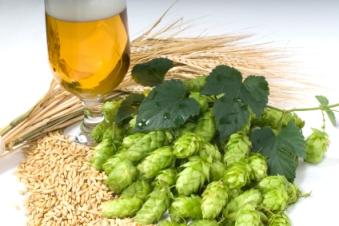
This week I take a look at cold, short duration dry hopping which seems counter-intuitive but has been shown to have its advantages for certain beers.
Scott Janish was the first one to mention cold dry hopping to me during a podcast in 2021 (Discussion starts around 42 min). He subsequently published a short article on his blog here making the case for cold dry hopping with a relatively short duration.
From a strict science perspective, the main purpose of dry hopping is to try to get relatively insoluble aromatic compounds into the beer. I’ve said many times that the reason these oils are aromatic is that they don’t like to stay in the beer. Typically it is easier to get a relatively insoluble compound into solution by applying either time or temperature or both.
So if we look at whirlpool hopping, for instance, we add hops at a relatively high temperature for a short amount of time (perhaps 10-40 minutes) in an effort to get some of the aromatic oils into solution. In contrast, dry hopping is done at relatively low fermentation or storage temperatures, but the hops are left in contact for a much longer period of time – usually 1-3 days and sometimes longer.
So it seems counterintuitive to think that dry hopping for a relatively short period of time at even colder temperatures is going to help aromatic oils get into the finished beer. However, the idea stuck in my head so I decided to dive deeper.
The Case for Shorter Dry Hop Times and Agitation
Lets first take a look at the optimal contact time for dry hopping. When I first started brewing we often dry hopped for a week or more or even used a technique called keg hopping where you literally left the hops in the keg until the beer was gone. However, the IPA revolution changed all of that, as brewers started to use extreme levels of dry hops for styles like Hazy IPAs, and we also gained a better understanding of dry hops.
For dry hopping, the goal is to get aromatic hop oils into the beer, but avoid more undesirable vegetal flavors. Brewers have found that many hop varieties are prone to creating vegetal, lawn mower or fresh cut grass flavors in the finished beer if dry hopped too long. So how much is enough?
Scott Janish notes in his article above that Wolf, Qian and Shellhammer published a study where they looked at aromatic compounds after dry hopping at the 1, 4 and 7 day timeframes. They found that some oils like myrcene and linalool, peak concentration was reached within 24 hours and in fact dropped slightly at 7 days. There is some evidence that the bulk of the extraction takes place in a matter of hours. Ref: (2012, The Effect of Pellet Processing and Exposure Time on Dry Aroma Extraction, ACS Symposium)
They did another test but this time added agitation by dry hopping on a shaker table to maximize extraction. In this case the linalool peaked in only four hours. As a result of this work, Scott now used much shorter contact times and has added agitation to his dry hop routine.
Another study (Reglitz, K., N. L., S. H., & M. S. (2018). On the Behavior of the Important Hop Odorant 4-Mercapto-4methylpentan-2-one (4MMP) during Dry Hopping and during Storage of Dry Hopped Beer. BrewingScience,71, 96-99) found that thiols also could be extracted quickly, and indeed peaked within two days of dry hopping.
If you want to learn more , Scott has a variety of sources listed here of studies that support the case for short dry hop times. Among the benefits are good hop oil extraction, better head retention, reduced hop creep and better Hazy IPA stability using a contact time of as little as 24-72 hours.
Cold Dry Hopping and Polyphenols
What about dry hop temperature? Scott cites research that found that dry hopping at a lower temperature reduces the polyphenol concentrations by a factor of two or more by dry hopping at 39 F (4 C) versus 66 F (19C). These polyphenols contributes to the aggressive bitterness we refer to as “hop bite” present in many Hazy IPAs. Time also played a role, with the level of polyphenols peaking at about 3 days and remaining stable through 14 days. So reducing the temperature and contact time can result in less hop bite. Ref: (Oladokun, O., James, S., Cowley, T., Smart, K., Hort, J., & Cook, D. (2017). Dry-Hopping: the Effects of Temperature and Hop Variety on the Bittering Profiles and Properties of Resultant Beers. BrewingScience, 70, 187-196.)
There is also evidence that hop creep is reduced by lowering dry hop temperatures and contact time, and as surprisingly the lower temperatures do not slow down the absorption of hop oils by very much.
Optimal Dry Hop Time and Temperature
So what is the optimal dry hop time and temperature? As always it is a balance of tradeoffs. For example an Hazy IPA with extreme levels of dry hops might benefit from a very short contact time of 1-2 days and low temperature (perhaps 39 F/4C) to reduce hop bite, hop creep and still retain most of the oil and thiol extraction. You also might want to apply agitation to the fermenter or rouse the hops every few hours to enhance extraction and shorten the time even further.
A more lightly hopped beer where hop bite and hop creep is not as big a risk might be OK with a longer 3 day contact time and slightly higher temperatures. For those interested in more details, I highly recommend Scott Janish’s detailed article here.
I hope you enjoyed this week’s article on cold dry hopping. Thank you for joining me this week on the BeersSmith blog – please subscribe to the newsletter or listen to my video podcast for more great material on homebrewing.
